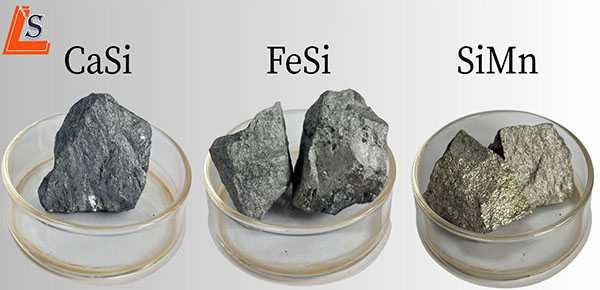Ferrosilicon (FeSi) is a key ferroalloy in steelmaking and foundry applications, serving as a deoxidizer, alloying agent, and inoculant. As cost and environmental pressures increase, various alternative alloys have emerged, driving industry upgrading.
1. Overview of Ferrosilicon (FeSi)
Ferrosilicon is an important ferroalloy composed of iron and silicon, with Si content ranging from 15% to 90%. Common grades include FeSi75, FeSi65, and FeSi45.
Applications:
Steelmaking: Deoxidizer, improving strength and elasticity.
Cast iron: Inoculant and nodulizer, enhancing mechanical properties.
Ore processing: Atomized FeSi powder for dense media separation.

2. Substitute Ferroalloys for Ferrosilicon
Driven by technical requirements and resource efficiency, several ferroalloys can partly replace FeSi in specific scenarios:
Silicon Manganese (SiMn)
Composition: Si 15–30%, Mn 60–70%.
Applications: Deoxidizer and Mn alloying agent for carbon and alloy steels.
Advantages: Dual role of Si + Mn, cost-efficient, reduces ferromanganese use.
Limitations: Low Si content, unsuitable for high-Si steels.
Calcium Silicon (CaSi)
Composition: Si 50–60%, Ca 25–35%.
Applications: Clean steels and stainless steels, combining deoxidation and desulfurization.
Advantages: Removes sulfur and inclusions effectively.
Limitations: Limited large-scale replacement due to restricted Si capacity.
Ferrosilicon Aluminum (FeSiAl)
Composition: Si 20–50%, Al 10–30%.
Applications: Deoxidizer for low-silicon and ultra-low-carbon steels, also used in foundries.
Advantages: Strong deoxidizing power of Al.
Limitations: May reduce toughness; often used alongside FeSi.
Rare Earth Ferrosilicon (RE-FeSi)
Composition: Si 40–70%, plus rare earths such as Ce, La.
Applications: Inoculant for ductile and gray cast iron, improving graphite morphology.
Limitations: Mainly applied in high-performance castings.
3. Market Status and Trends
Ferrosilicon: China produced ~5.5 Mt in 2024, exporting ~0.5 Mt. Market prices fluctuate with electricity, quartz supply, and steel demand.
Alternative ferroalloys:
FeSiMn: Large output, dominant substitute in carbon steels.
CaSi: Used in stainless and clean steels, stable but niche demand.
FeSiAl: Increasing adoption for specialized deoxidation.
RE-FeSi: Small-scale use in high-end cast iron.
Trends:
Ferrosilicon remains dominant in standard steels; high-end steels move toward composite alloys or metallic silicon.
Composite alloys (e.g., CaSiAl, CaSiBa) are gaining traction to reduce multiple additions.
Steelmakers are accelerating substitution strategies due to market fluctuations.
Green metallurgy promotes the use of silicon carbide (SiC) and other low-carbon alloys.
4. Conclusion
Ferrosilicon remains the core silicon source in global steelmaking due to its versatility and proven performance. Alternative ferroalloys supplement their shortcomings through specialized functions:
Purity control → metallic silicon or CaSi.
Inclusion modification → CaSi alloys.
Simplified deoxidation → FeSiAl.
Simultaneous Si + C addition → SiC.
The optimal strategy for steelmakers is a flexible combination of FeSi and substitutes, tailored to product grade and process requirements. The future of alloying lies not in a single replacement but in complementary, efficient, and greener alloy solutions.
Since its establishment in 1999, LSFerroalloy has been committed to supplying high-quality ferroalloys. With reliable product performance and dedicated service, the company has earned the trust of customers worldwide.
